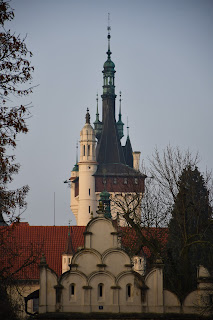Day 2 of Lounging in Luanda
On my second day in Luanda, I took a guided tour of the city. I had originally booked it since I was a little concerned for my safety in the farther reaches of Luanda and since I also wanted to visit the so-called Viewpoint of the Moon, which can only be reached by car or public transit as it lies over an hour southwest of the city. The Viewpoint of the Moon was the first place we visited. It is a lookout over a barrage of red and beige pinnacles that have been eroded out of the cliff close to the sea, forming a moonlike arena whose bottom is filled with small hills and baobab trees. I imagine these trees must be of special pre-Christan significance to local people, as there is an entire hilly grove of baobabs by the road just south of Luanda where people go – our guide said – “to be closer to God.”
Our guide
passed the ride by talking about the things we could see outside the car
window. I shared the tour with a Brazilian tourist, and I found I could
understand the guide’s Portuguese much better than his, following which
realisation I started telling the guide he could stop translating for me while
I continued responding to him in English. The guide said over two thirds of all
Angolans enslaved by the Portuguese were sent to Brazil, which is why Brazil
continues to bear traces of African culture, for example in the syncretistic
religious practice of candomblé. In turn, he said Angolans consume a lot of
Brazilian media as local news cannot be trusted. From there, the conversation
naturally led to politics. There had been protests in July over rising oil
prices during which several dozen people were indiscriminately killed by the
police. The guide showed us a gruesome photo of a young man who had been shot
in the head, and another sequence of pictures in which a woman was being shot
from behind. Many such photos and videos had been shared on social media, a
phenomenon that the regime has found it impossible to suppress.
Our next
stop was the Museum of Slavery, which lies on the coast between urban Angola
and the Viewpoint of the Moon. The museum is housed in the old residence of the
captain of the local presidio, whose chapel is where enslaved Africans were
baptised and given new Christian names before being loaded onto ships and sent
to Europe or the Americas. One information board in the museum sets out the
different prices assigned to people under this system: buyers would pay a
different sum for people based on their sex and age, with several price categories
from adult men and women all the way to babies.
Back in the
city, we drove around the different ministries, the Presidential Residence and
the National Assembly, which is built in the same pink and
beige colour scheme as the old building of the National Bank. We slowed down for a bit too long
by the assembly, and the policemen on patrol by the intersection appeared to
gesture at the driver to come meet them. He, however, ignored them and drove on.
For a few long minutes, the guide kept looking through the back window fretfully
to see if we were being followed. There was little traffic and soon,
doubtlessly spurred on by the adrenaline of this situation, we found ourselves
by the port authority, where we swung around and set ourselves on the seaside
road to the Fortress of São Miguel.
We were among only a small handful of visitors to the
fortress that day. Our guide took us into the courtyard, which houses several
statues of Portuguese explorers as well as old bells and canons, after which we
ascended the ramparts. The walls of São Miguel offer one of the best views of Luanda. To
the east, they overlook the bay, which is dominated by the sprawling pink and
beige building of the National Bank and several skyscrapers. To the west, they
overlook a poorer neighbourhood on the sea that is set to be demolished to make
way for new developments. And to the south, the walls gaze directly onto the
hill where all the government buildings stand. Our guide claimed that the beige
palatial building on the close side of the hill serve as the quarters of the
president’s son.
Our final stop before returning to the airport was the
Iron Palace: a yellow building with concave roofs and ornate metal fencing. Our
guide claimed that Gustave Eiffel got lost on his way to Madagascar and was
allowed to build himself this house while he waited to receive more accurate
maps. In reality, it is unclear whether Eiffel designed the building and near
certain that he never visited Angola. What actually happened was the house
itself was en route to Madagascar when the ship ran aground in Angola and was
claimed by the Portuguese. At present, the palace is empty, but it may be
turned into a museum or a restaurant in the future.






















Comments
Post a Comment